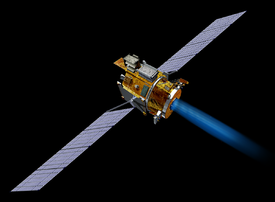
Back ديب سبيس 1 Arabic Deep Space 1 Byelorussian Дийп Спейс 1 Bulgarian Deep Space 1 Catalan Deep Space 1 Czech Deep Space 1 German Deep Space 1 Spanish Deep Space 1 Basque فضاپیمای دیپ اسپیس۱ Persian Deep Space 1 Finnish
This article needs additional citations for verification. (October 2012) |
 Artist concept of Deep Space 1 | |||||||||
| Mission type | Technology demonstrator | ||||||||
|---|---|---|---|---|---|---|---|---|---|
| Operator | NASA / JPL | ||||||||
| COSPAR ID | 1998-061A | ||||||||
| SATCAT no. | 25508 | ||||||||
| Website | http://www.jpl.nasa.gov/missions/deep-space-1-ds1/ | ||||||||
| Mission duration | 3 years, 1 month and 24 days | ||||||||
| Spacecraft properties | |||||||||
| Manufacturer | Orbital Sciences Corporation | ||||||||
| Launch mass | 486 kg (1,071 lb)[1] | ||||||||
| Dry mass | 373 kg (822 lb)[1] | ||||||||
| Dimensions | 2.1 × 11.8 × 2.5 m (6.9 × 38.6 × 8.2 ft) | ||||||||
| Power | 2,500 watts[1] | ||||||||
| Start of mission | |||||||||
| Launch date | 24 October 1998, 12:08 UTC[2] | ||||||||
| Rocket | Delta II 7326[1] | ||||||||
| Launch site | Cape Canaveral SLC-17A[1] | ||||||||
| End of mission | |||||||||
| Disposal | Decommissioned | ||||||||
| Deactivated | 18 December 2001, 20:00 UTC[2] | ||||||||
| Flyby of 9969 Braille | |||||||||
| Closest approach | 29 July 1999, 04:46 UTC[2] | ||||||||
| Distance | 26 km (16 mi) | ||||||||
| Flyby of 19P/Borrelly | |||||||||
| Closest approach | 22 September 2001, 22:29:33 UTC[2] | ||||||||
| Distance | 2,171 km (1,349 mi) | ||||||||
| |||||||||
 DS1 mission logo | |||||||||
Deep Space 1 (DS1) was a NASA technology demonstration spacecraft which flew by an asteroid and a comet. It was part of the New Millennium Program, dedicated to testing advanced technologies.
Launched on 24 October 1998, the Deep Space 1 spacecraft carried out a flyby of asteroid 9969 Braille, which was its primary science target. The mission was extended twice to include an encounter with comet 19P/Borrelly and further engineering testing. Problems during its initial stages and with its star tracker led to repeated changes in mission configuration. While the flyby of the asteroid was only a partial success, the encounter with the comet retrieved valuable information.
The Deep Space series was continued by the Deep Space 2 probes, which were launched in January 1999 piggybacked on the Mars Polar Lander and were intended to strike the surface of Mars (though contact was lost and the mission failed). Deep Space 1 was the first NASA spacecraft to use ion propulsion rather than the traditional chemical-powered rockets.[3]
- ^ a b c d e "Deep Space 1 Asteroid Flyby" (PDF) (Press kit). NASA. 26 July 1999. Archived (PDF) from the original on 16 November 2001. Retrieved 20 November 2016.
- ^ a b c d "Deep Space 1". National Space Science Data Center. NASA. Retrieved 20 November 2016.
- ^ Siddiqi, Asif A. (2018). Beyond Earth: A Chronicle of Deep Space Exploration, 1958–2016 (PDF). NASA History Series (2nd ed.). NASA. p. 2. ISBN 978-1-62683-042-4. LCCN 2017059404. SP-2018-4041. Archived (PDF) from the original on 24 April 2019.
© MMXXIII Rich X Search. We shall prevail. All rights reserved. Rich X Search